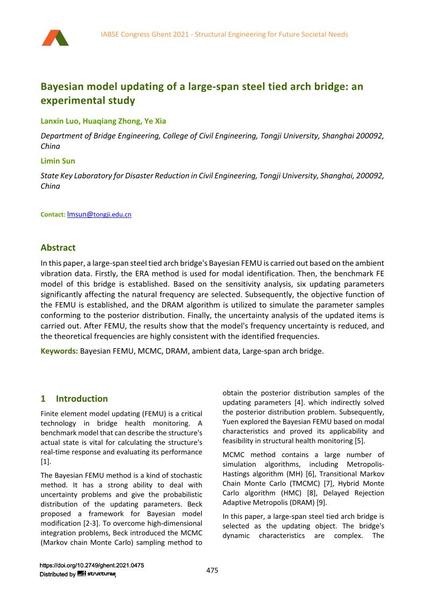Bayesian model updating of a large-span steel tied arch bridge: an experimental study

|
|
|||||||||||
Détails bibliographiques
| Auteur(s): |
Lanxin Luo
(Department of Bridge Engineering, College of Civil Engineering, Tongji University, Shanghai 200092, China)
Huaqiang Zhong (Department of Bridge Engineering, College of Civil Engineering, Tongji University, Shanghai 200092, China) Ye Xia (Department of Bridge Engineering, College of Civil Engineering, Tongji University, Shanghai 200092, China) Limin Sun |
||||
|---|---|---|---|---|---|
| Médium: | papier de conférence | ||||
| Langue(s): | anglais | ||||
| Conférence: | IABSE Congress: Structural Engineering for Future Societal Needs, Ghent, Belgium, 22-24 September 2021 | ||||
| Publié dans: | IABSE Congress Ghent 2021 | ||||
|
|||||
| Page(s): | 475-480 | ||||
| Nombre total de pages (du PDF): | 6 | ||||
| DOI: | 10.2749/ghent.2021.0475 | ||||
| Abstrait: |
In this paper, a large-span steel tied arch bridge's Bayesian FEMU is carried out based on the ambient vibration data. Firstly, the ERA method is used for modal identification. Then, the benchmark FE model of this bridge is established. Based on the sensitivity analysis, six updating parameters significantly affecting the natural frequency are selected. Subsequently, the objective function of the FEMU is established, and the DRAM algorithm is utilized to simulate the parameter samples conforming to the posterior distribution. Finally, the uncertainty analysis of the updated items is carried out. After FEMU, the results show that the model's frequency uncertainty is reduced, and the theoretical frequencies are highly consistent with the identified frequencies. |
||||
| Copyright: | © 2021 International Association for Bridge and Structural Engineering (IABSE) | ||||
| License: | Cette oeuvre ne peut être utilisée sans la permission de l'auteur ou détenteur des droits. |
||||
